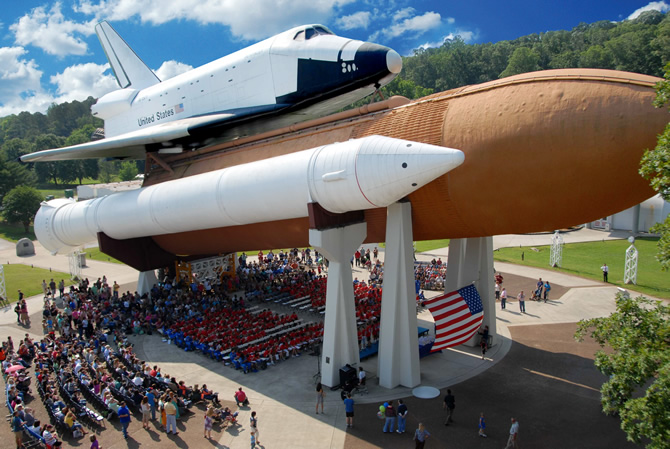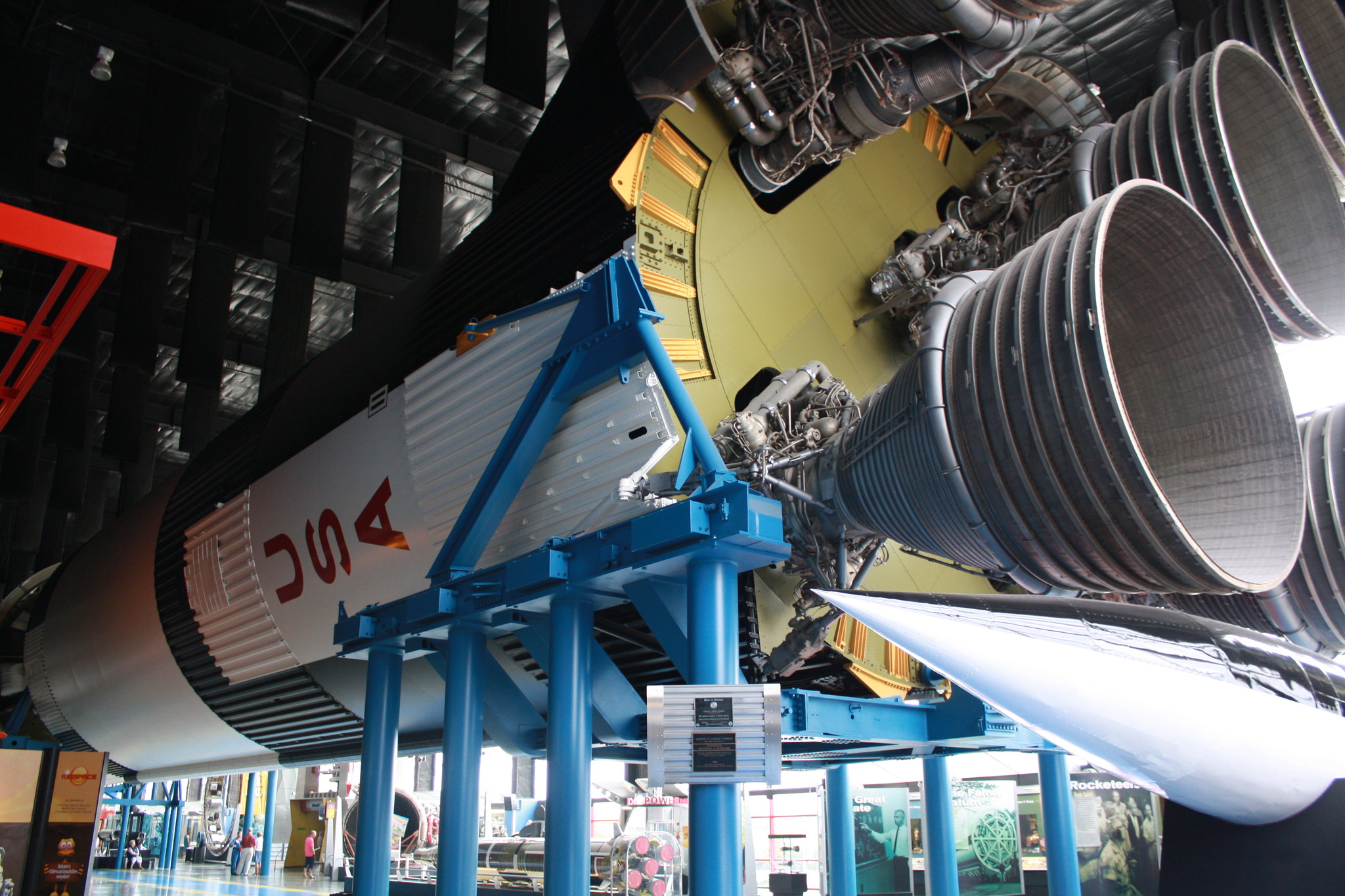The U.S. Space & Rocket Center in Huntsville showcases the rockets, achievements, and artifacts of the space program, as well as the legacy of Wernher von Braun and his team.
-
Winter 2022
Volume67Issue1
Editor’s Note: Brent Glass is Director Emeritus of the Smithsonian’s National Museum of American History and the author of 50 Great American Places: Essential Historic Sites Across the U.S.

On May 2, 1945, in the Bavarian town of Schattwald, a young man on a bicycle rode up to American troops and announced, “We are a group of rocket specialists up in the mountains. My brother invented the V-2. We want to surrender.”
The young man was Magnus von Braun and his brother was Wernher von Braun, director of Germany’s V-2 missile program. Within a few years, von Braun would be directing the U.S. space program and the team that designed the Saturn V rocket, the most powerful ever built. From 1964 to 1973, the United States used Saturn V rockets for 13 missions, including six lunar landings. On July 20, 1969, a Saturn V — powered rocket- launched Apollo 11, which landed on the moon, and two astronauts, Neil Armstrong and Buzz Aldrin, became the first people to walk on its surface.
Finding von Braun and the other German engineers and scientists was an important objective for the Americans. They needed to locate German weapons, to learn how they were made, and to find this in-formation before the Soviet Union did. They called their program Operation Paperclip, reflecting the extensive files maintained on German scientists. Once they had custody of von Braun, American officials had a difficult decision to make. They could consider him and his colleagues prisoners of war and charge them with war crimes in light of their work on behalf of the Nazi regime on rocket missiles used against Britain and other countries during the war. On the other hand, America needed their expertise to develop the next generation of weaponry.
For five years, the von Braun brothers and 116 German engineers worked as alien employees at Fort Bliss near El Paso, Texas, where they tested rockets at the White Sands Proving Ground in New Mexico. In 1950, the Army relocated the rocket research program to Redstone Arsenal in Huntsville, Alabama, a good site for classified research. It was federally owned land, a former Army chemical depot with many empty munitions assembly buildings and lots of acreage for future growth. And most decisively, Huntsville was the home of Alabama’s junior senator, John Sparkman, who sought more military spending in his state.
At Redstone, Wernher von Braun guided the American rocket program. A brilliant physicist and engineer, he was also a talented leader and administrator. Although he had spent his career designing missiles as weapons, his lifelong dream was to adapt this technology for space exploration. The opportunity came on October 4, 1957, when the Soviet Union launched Sputnik, the first satellite to orbit the earth.
The United States quickly responded to the success of Sputnik. In December 1957, von Braun’s team started work on the Jupiter and Saturn rocket systems. In 1958, Congress established the National Aeronautic and Space Administration (NASA), and within a year, all space-related programs were transferred from the Army to NASA. In 1960, President Eisenhower came to Huntsville to dedicate the Marshall Space Flight Center, named for General George C. Marshall, the former secretary of state, whose Marshall Plan rebuilt Europe after World War II. In May 1961, President Kennedy pledged full support to “landing a man on the moon and returning him safely to earth” by 1970.
The national commitment to the space program reflected Cold War priorities, intelligence and defense, as well as the need for scientific research. Most important, Kennedy believed it was feasible to land a man on the moon before the Soviet Union and thus reap the benefits of international prestige. Congress followed his lead and approved enormous funding for NASA. After testing smaller rockets, NASA announced plans to build Saturn V, a rocket powerful enough to launch Apollo 11 for a moon landing.
Saturn V was an engineering marvel. At 363 feet—taller than the Statue of Liberty—and 6.2 million pounds, it towered over other rockets. A three-stage rocket with multiple engines fueled by liquid hydrogen, it utilized a Lunar Orbit Rendezvous (LOR), in which a small modular spacecraft separated from the main spacecraft, landed on the moon, and linked up with the main spacecraft before returning to Earth.
More than 20,000 contracting companies — led by Boeing, North American Aviation, Douglas Aircraft, and IBM — fabricated 3 million parts that made up 700,000 components in a single rocket. The cost of the program over nine years totaled $6.5 billion, the equivalent of $46 billion in 2013. The only comparable government program in ambition, complexity, and expense was the Manhattan Project, which produced the atomic bomb.
The cost of the program led to its demise. After the lunar landings that followed Apollo 11, Americans lost enthusiasm for the space race and questioned the scientific value of manned flights. Subsequent ventures — Skylab, Spacelab, the Space Shuttle, and the International Space Station — have been productive and less costly.

In Huntsville, NASA’s Marshall Space Flight Center continues to develop and test space vehicles and supports research on rocket engines and new ways to live and work in space such as the Space Launch System. The U.S. Space & Rocket Center, located a few miles away, offers bus tours around the center and Redstone Arsenal.
The Rocket Center, established in 1970 by the Alabama legislature, provides educational programs about the history of space exploration and displays a rich collection of space technology. The center is the home of Space Camp, an experiential learning program for teachers and families. The highlight of a visit to the center is an original National Historic Landmark Saturn V rocket, used in the 1960s for vibration testing.
The idea for the Rocket Center, Space Camp, and the Saturn V exhibit came from Wernher von Braun himself. From the time he and his countrymen arrived in Huntsville in 1950, they embraced their rural Alabama home. They established a symphony orchestra, promoted a state university branch campus, and encouraged aerospace companies to locate regional offices there. Many, including von Braun, became American citizens.
Despite their German accents and the bitter memories of World War H, these scientists created a legacy of friendship and respect. In 1975, Huntsville named its civic arts and convention center in honor of Wernher von Braun.
In a quiet corner of the Space Center’s museum, little noticed by most visitors, is an old bicycle, the one Magnus von Braun rode down the mountain in Bavaria, never dreaming of the epochal ride into outer space and the extraordinary technology that would follow.

